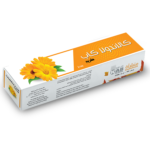lightening and whitening with ARBU WHITE
Arbutin
Arbutin is one of the most widely prescribed skin-lightening and de-pigmenting agent worldwide. Arbutin, the b-D-glucopyranoside derivative of hydroquinone, is a naturally occurring plant derived compound found in the dried leaves of a number of different plant species including, bearberry (Arctostaphylos uva-ursi), blueberry, cranberry, and pear trees. Arbutin, inhibits tyrosinase activity competitively but at non-cytotoxic concentrations in a dose dependent manner in cultured melanocytes.[18] It also inhibits melanosome maturation and is less cytotoxic to melanocytes than hydroquinone. Although, higher concentrations may be more efficacious, greater risk for paradoxical hyperpigmentation exists.
Controlled trials on treating hyperpigmentation are lacking. However, several studies have shown that arbutin is less effective than kojic acid for hyperpigmentation. Deoxyarbutin is a synthesized topical derivative. Studies have shown that it has an enhanced sustained improvement, general skin lightening and a safety profile comparable to hydroquinone.[19]
18. Maeda K, Fukuda M. Arbutin: Mechanism of its depigmenting action in human melanocyte culture. J Pharmacol Exp Ther. 1996;276:765–9. [PubMed] [Google Scholar]
19. Boissy RE, Visscher M, DeLong MA. DeoxyArbutin: A novel reversible tyrosinase inhibitor with effective in vivo skin lightening potency. Exp Dermatol. 2005;14:601–8. [PubMed] [Google Scholar]
Kojec acid:
Several substituents are combined into kojic acid at its 2-hydroxymethyl group. Some kojic acid derivatives are synthesized and evaluated for their ability to inhibit d-amino acid oxidase (DAAO). These analogs act as beneficial molecular probes to explore the secondary binding site, which could be used in designing more potent inhibitors [27]
27- M. Raje, et al.Synthesis of kojic acid derivatives as secondary binding site probes of D-amino acid oxidase
Bioorg. Med. Chem. Lett., 23 (13) (2013), pp. 3910-3913
Human skin exposure to ultraviolet light can cause many skin lesions, such as sunburn, skin cancer, and oxidative stress, all of which depend on the intensity and amount of UV light [28,29]. KA can be used as a UV protector, with the ability to restrict hyperpigmentation tyrosinase inhibitory effect [2,[30], [31], [32], [33], [34], [35], [36]]. Side effects of hydroquinone (HQ) as a popular skin lightener has made KA a suitable substitution in cosmetic products [2,37]. This review describes and discusses the application and high capacity of KA, as a lightening agent in cosmetic and health care preparations
28-M.A. Ebrahimzadeh, et al.Correlation between sun protection factor and antioxidant activity, phenol and flavonoid contents of some medicinal plants
Iranian journal of pharmaceutical research: IJPR, 13 (3) (2014), p. 1041
29-N.S. Pour, et al.Sun protection for children: a review
J. Pediatr. Rev., 3 (1) (2015)
2-M. SaeediAn Overview of Cosmetics and Toiletries
30-J. Cabanes, S. Chazarra, F. Garcia–CarmonaKojic acid, a cosmetic skin whitening agent, is a slow‐binding inhibitor of catecholase activity of tyrosinase
J. Pharm. Pharmacol., 46 (12) (1994), pp. 982-985
31-E.V. Curto, et al.Inhibitors of mammalian melanocyte tyrosinase: in vitro comparisons of alkyl esters of gentisic acid with other putative inhibitors
Biochem. Pharmacol., 57 (6) (1999), pp. 663-672
33-K. Sasaki, F. YoshizakiNobiletin as a tyrosinase inhibitor from the peel of Citrus fruit
Biol. Pharm. Bull., 25 (6) (2002), pp. 806-808
32-Y.M. Kim, et al.Oxyresveratrol and hydroxystilbene compounds inhibitory effect on tyrosinase and mechanism of action
J. Biol. Chem., 277 (18) (2002), pp. 16340-16344
34-M. Ishikawa, I. Kawase, F. IshiiCombination of amino acids reduces pigmentation in B16F0 melanoma cells
Biol. Pharm. Bull., 30 (4) (2007), pp. 677-681
35-P. Donsing, N. Limpeanchob, J. ViyochEvaluation of the effect of Thai breadfruit’s heartwood extract on melanogenesis-inhibitory and antioxidation activities
J. Cosmet. Sci., 59 (1) (2008), pp. 41-58
36-O. Abdel-Halim, et al.A new tyrosinase inhibitor from Crinum yemense as potential treatment for hyperpigmentation
Die Pharmazie-An International Journal of Pharmaceutical Sciences, 63 (5) (2008), pp. 405-407
37-S. Emami, et al.Kojic acid and its manganese and zinccomplexes as potential radioprotective agents
Bioorg. Med. Chem. Lett., 17 (1) (2007), pp. 45-48
 Previous Post
Previous Post Next Post
Next Post